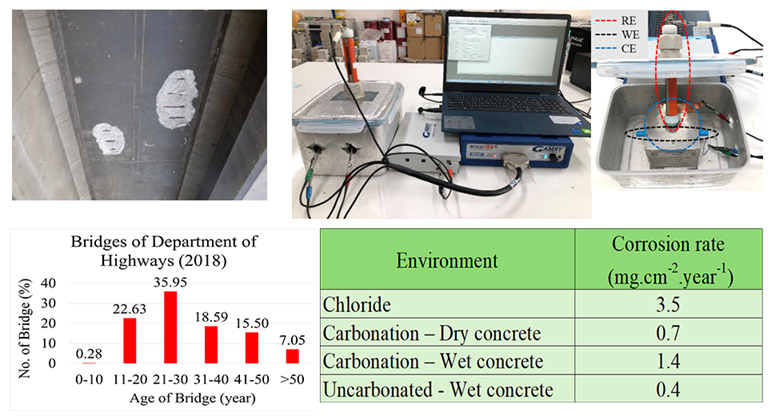Maintenance of the deteriorated infrastructure in Thailand
DOI:
https://doi.org/10.55713/jmmm.v34i3.1916Keywords:
corrosion, Reinforced concrete, Chloride induced corrosion, CarbonationAbstract
Infrastructure has been aged and deteriorated by various causes. Maintenance of its safety and serviceability are crucial and many countries have raised concerns about the existing infrastructure. Infrastructure in Thailand has been also aged. This paper shows results of studies relating to maintenance of infrastructure in Thailand. Inspection of the existing infrastructure in Bangkok was conducted by both visual and non-destructive testing (NDT) showing many deteriorations, and damages. Most of the deteriorations are caused by low concrete covering depth and water leakage. While in marine environment, chloride attack is the main cause. Evaluation criteria for NDT results are studied and modified to be suitable for concrete used in Thailand. To predict the service life of structure, studies have also been conducted to evaluate the corrosion rate of reinforcing steel in reinforced concrete structures in different deterioration mechanisms and environmental conditions. Together with inspection results, service life of structure can be predicted, and maintenance can be well planned. The results of this study could raise awareness of the important of infrastructure maintenance in Thailand.
Downloads
References
American Society of Civil Engineer, A comprehensive assessment of America’s infrastructure, www.infrastructurereportcard.org, USA, 2021.
Japan Society of Civil Engineers, Japan report. Japan’s Infrastructure Grades 2020 & Introduction of Maintenance Technologies, https://www.jsce-int.org/system/files/ Infrareport_ Japan_2021.pdf, Japan, 2021.
Department of Highways, List of bridges in BMMS database system, http://maintenance.doh.go.th/website/index.php/download- main/126-bmms, Thailand, 2018 (in Thai)
Department of Public Works and Town & Country Planning of Thailand, DPT 1501-51 Standards of structural visual inspection, DPT Standard, Phayathai, Bangkok, 2008
Department of Public Works and Town & Country Planning of Thailand, DPT 1502-51 Standards of concrete testing by rebound hammer, DPT Standard, Phayathai, Bangkok, 2008.
Department of Public Works and Town & Country Planning of Thailand, DPT 1505-51 Standards of testing of location of reinforcing steel by covermeter, DPT Standard, Phayathai, Bangkok, 2008.
European Standard, EN 12390-19 Testing of hardened concrete - Determination of electrical resistivity, European Standard, European Committee for Standardization, 2023.
Department of Public Works and Town & Country Planning of Thailand, DPT 1902-62 Standards of inspection, evaluation, repairing and strengthening of the existing and damaged building, DPT Standard, Phayathai, Bangkok, 2019
C. Andrade, C. Alonso, Test methods for on-site corrosion rate measurement of steel reinforcement in concreteby means of the polarization resistance method, Materials and Structures, vol. 37, pp. 623-643, 2004 DOI: https://doi.org/10.1007/BF02483292
D. Network, Manual de inspección, evaluación y diagnóstico de corrosión en estructuras de hormigón armado, CYTED Programe, France, 1997.
D. V. P. Tran, P. Sancharoen, P. Klomjit, and S. Tangtermsirikul, Effects of concrete mix proportion and chloride content on electrochemical properties of reinforcing steel in concrete. Engineering Journal, vol. 24, no.3, p. 23-34, 2020. DOI: https://doi.org/10.4186/ej.2020.24.3.23
S. W. Hnin, P. Sancharoen, and S. Tangtermsirikul, Effects of concrete mix proportion on electrical resistivity of concrete, Materials Science Forum 866, pp.68-72, 2016. DOI: https://doi.org/10.4028/www.scientific.net/MSF.866.68
D. V. P. Tran, P. Sancharoen, P. Klomjit, and S. Tangtermsirikul, Electrical resistivity and corrosion potential of reinforced concrete: influencing factors and prediction models, Journal of Adhesion Science and Technology, vol. 34, no. 19, pp.2107-2119, 2020. DOI: https://doi.org/10.1080/01694243.2020.1750784
Japan Society of Civil Engineers, JSCE Guidelines for concrete No.17 - Standard specifications for concrete structures - "Maintenance", Japan Society of Civil Engineers, Japan, 2007.
S. Rath, P. Sancharoen, P. Klomjit, and S. Tangtermsirikul, Effects of carbonation on corrosion rate of reinforcing steel in different concrete and repair materials, Engineering Journal, vol. 25, no. 6, pp. 75-86, 2021. DOI: https://doi.org/10.4186/ej.2021.25.6.75
D. V. P. Tran, Modeling of electrochemical corrosion of reinforcing steel in patching-repaired reinforced concrete, Ph. D. dissertation, Sirindhorn International Institute of Technology, Thammasat University, Thailand, 2020.

Downloads
Published
How to Cite
Issue
Section
License
Copyright (c) 2024 Journal of Metals, Materials and Minerals

This work is licensed under a Creative Commons Attribution-NonCommercial-NoDerivatives 4.0 International License.
Authors who publish in this journal agree to the following terms:
- Authors retain copyright and grant the journal right of first publication with the work simultaneously licensed under a Creative Commons Attribution License that allows others to share the work with an acknowledgment of the work's authorship and initial publication in this journal.
- Authors are able to enter into separate, additional contractual arrangements for the non-exclusive distribution of the journal's published version of the work (e.g., post it to an institutional repository or publish it in a book), with an acknowledgment of its initial publication in this journal.












